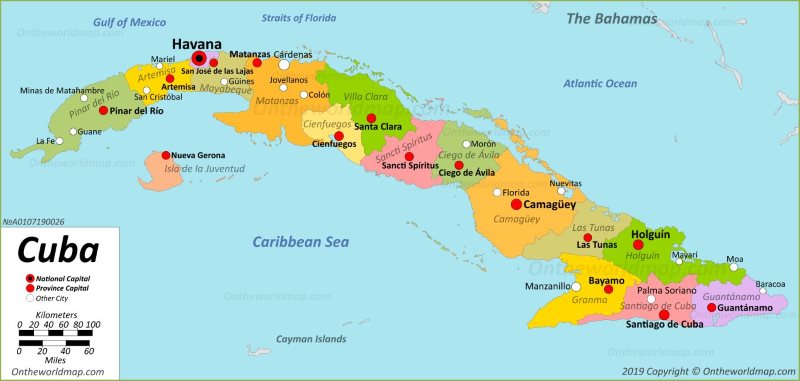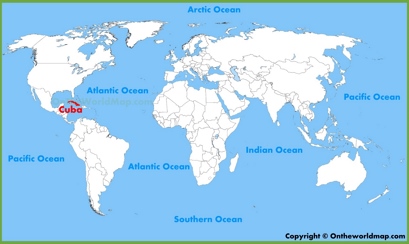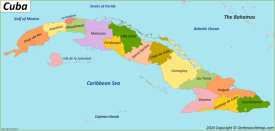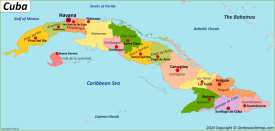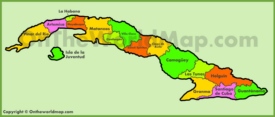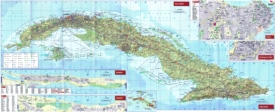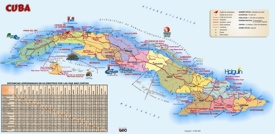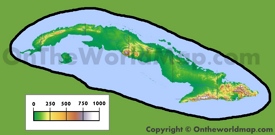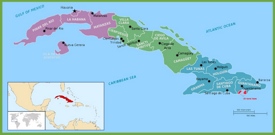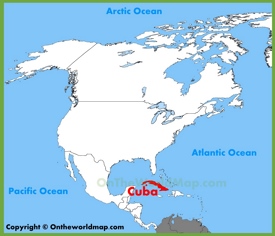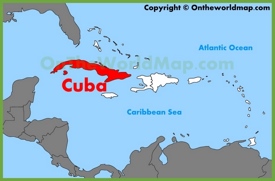Cuba Map
Description:
This map shows islands, provinces, province capitals and major cities in Cuba.
Size: 1500x714px / 379 Kb
1365x650px / 124 Kb
Author: Ontheworldmap.com
You may download, print or use the above map for educational, personal and non-commercial purposes. Attribution is required. For any website, blog, scientific research or e-book, you must place a hyperlink (to this page) with an attribution next to the image used.
Page Navigation
Cuba Location Map
Online Map of Cuba
Detailed Maps of Cuba
About Cuba
Located in the Caribbean region, the enchanting country of Cuba is a tropical paradise known for its vibrant culture, breathtaking landscapes, and fascinating history. With its strategic location between the Caribbean Sea, Gulf of Mexico and the Atlantic Ocean, Cuba is the largest island in the Caribbean archipelago, spanning over 1,200 kilometers from east to west. It is located south of the American state of Florida, east of the Mexico, southeast of the Bahamas, west of Haiti, and north of Jamaica and the Cayman Islands.
The Facts:| Flag: |
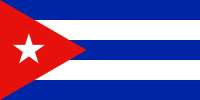
|
| Capital: | Havana |
| Area: | 42,800 sq mi (110,860 sq km) |
| Population: | ~ 10,950,000 |
| Official language: | Spanish |
| Religion: |
|
| Ethnic groups: |
|
| Currency: | Cuban peso (CUP) |
| Driving side: | right |
| Calling code: | +53 |
| Internet TLD: | .cu |
| Time zone: | UTC−5 (CST) Summer (DST) UTC−4 (CDT) |
| Gross domestic product (PPP): |
|
| Gross domestic product (nominal): |
|
Google Map of Cuba
History of Cuba
Cuba's rich history is intertwined with colonial influences, revolution, and a unique socialist system. Spanish rule lasted for over 400 years until 1898, when Cuba gained independence from Spain following the Spanish-American War. The mid-20th century witnessed the Cuban Revolution led by Fidel Castro, which transformed the country's socio-political landscape. The influence of the revolution can be seen through Cuba's commitment to education, healthcare, and social equality.
Cities in Cuba
Havana, the vibrant capital of Cuba, is a fascinating blend of old-world charm and vibrant modernism. Known for its colorful colonial architecture, iconic vintage cars, and lively music scene, Havana offers visitors an immersive cultural experience. The city's historic center, "La Habana Vieja," is a UNESCO World Heritage site and home to notable landmarks such as El Capitolio, Plaza de la Catedral, and Castillo de la Real Fuerza. Strolling through the narrow streets, visitors can soak up the lively atmosphere, enjoy live music performances, and savor delicious local cuisine.
In addition to Havana, Cuba boasts several other impressive cities. Santiago de Cuba, the second-largest city and cultural capital, is known for its Afro-Cuban roots and vibrant carnival celebrations. Trinidad, a colonial gem, takes visitors on a journey back in time with its well-preserved Spanish architecture. Cienfuegos, often referred to as the "Pearl of the South," enchants visitors with its elegant French-inspired buildings and beautiful bay.
List of Largest Cities in Cuba
- Havana (2,165,000)
- Santiago de Cuba (1,340,000)
- Holguín (1,040,000)
- Camagüey (330,000)
- Guantánamo (290,000)
- Santa Clara (245,000)
- Bayamo (240,000)
- Las Tunas (210,000)
- Pinar del Río (190,000)
- Cienfuegos (180,000)
- Matanzas (165,000)
- Ciego de Ávila (155,000)
- Cárdenas (154,000)
- Sancti Spíritus (145,000)
- Manzanillo (130,000)
Tourism in Cuba
This stunning island nation boasts diverse geographical features, including stunning coastlines, picturesque mountains, and fertile plains. The pristine beaches and crystal-clear turquoise waters lure travelers from all over the world. Varadero, Cayo Coco, and Guardalavaca are some of the main beach resort areas that captivate visitors with their white sandy shores and stunning coral reefs, providing a paradise for snorkeling and scuba diving enthusiasts.
Tourism plays a vital role in Cuba's economy, and the country boasts an array of attractions both for leisure and adventure seekers. In addition to the stunning beaches, visitors can explore the lush Viñales Valley, renowned for its tobacco plantations and picturesque landscapes. The Sierra Maestra mountain range offers opportunities for hiking and exploring historical sites, including the hideouts of Fidel Castro and Che Guevara during the revolution.
For those interested in history and culture, Cuba provides a treasure trove of museums, art galleries, and vibrant music and dance performances. The Museum of the Revolution, located in Havana, showcases the country's struggle for independence and its revolutionary history. The National Museum of Fine Arts houses an extensive collection of Cuban art. The sounds of salsa, rumba, and Afro-Cuban jazz can be enjoyed in bars and clubs throughout the country.
Cuba is a country with a rich tapestry of natural beauty, cultural heritage, and a captivating history. From its stunning coastlines and vibrant cities to its revolutionary legacy and warm hospitality, there is something for everyone to explore and enjoy in this Caribbean gem.
The Best Beaches and Coastal Towns in Cuba
- Varadero
- Cayo Coco
- Santiago de Cuba
- María La Gorda
- Matanzas
- Baracoa
- Cienfuegos
- Cayo Romano
- Cayo Guillermo
- Guardalavaca
- Cayo Jutías
- Guanabo
- Gibara
- Playa Giron
- Puerto Padre
Main sights in Cuba
- Habana Vieja
- Varadero
- Cayo Coco
- Trinidad
- Parque Nacional Viñales
- The Malecon
- Baracoa
- Che Guevara Mausoleum
- Castillo del Morro
- Castillo de San Pedro de la Roca
- Grand Theater of Havana
- Museo Nacional de Bellas Artes
- El Nicho Waterfalls
- Plaza Vieja
- Playa Paraiso
- El Capitolio
Provinces of Cuba
| Province | Capital | Area | Population |
|---|---|---|---|
| Camagüey | Camagüey | 5,941 sq mi (15,386 sq km) | 770,000 |
| Ciego de Ávila | Ciego de Ávila | 2,692 sq mi (6,972 sq km) | 505,000 |
| Cienfuegos | Cienfuegos | 1,617 sq mi (4,189 sq km) | 870,000 |
| La Habana | Havana | 281 sq mi (728 sq km) | 2,240,000 |
| Granma | Bayamo | 3,233 sq mi (8,374 sq km) | 830,000 |
| Guantánamo | Guantánamo | 2,381 sq mi (6,168 sq km) | 510,000 |
| Holguín | Holguín | 3,558 sq mi (9,216 sq km) | 1,025,000 |
| Isla de la Juventud | Nueva Gerona | 934 sq mi (2,419 sq km) | 85,000 |
| Artemisa | Artemisa | 1,546 sq mi (4,003 sq km) | 515,000 |
| Las Tunas | Las Tunas | 2,545 sq mi (6,593 sq km) | 540,000 |
| Matanzas | Matanzas | 4,553 sq mi (11,792 sq km) | 825,000 |
| Mayabeque | San José de las Lajas | 1,445 sq mi (3,744 sq km) | 385,000 |
| Pinar del Río | Pinar del Río | 3,430 sq mi (8,884 sq km) | 580,000 |
| Sancti Spíritus | Sancti Spíritus | 2,617 sq mi (6,777 sq km) | 470,000 |
| Santiago de Cuba | Santiago de Cuba | 2,405 sq mi (6,228 sq km) | 1,040,000 |
| Villa Clara | Santa Clara | 3,259 sq mi (8,442 sq km) | 785,000 |
Geography of Cuba
Main Islands of Cuba
- Jardines de la Reina
- Canarreos
- Sabana-Camagüey
- Cayo Coco
- Cayo Cruz del Padre
- Cayo Fragoso
- Cayo Guajaba
- Cayo Guillermo
- Cayo Largo del Sur
- Cayo Levisa
- Cayo Romano
- Cayo Sabinal
- Cayo Saetia
- Cayo Santa María
- Ernst Thälmann Island
- Isla de la Juventud
- Colorados
- Jardines del Rey
Major Rivers of Cuba
- Cauto
- Toa
- Guama
- Yumuri
- Almendares
- Sagua la Chica
- Cuyaguateje
- Mayabeque
- Guantánamo
Mountains of Cuba
- Pico Turquino (6,476ft)
- Gran Piedra (4,098ft)
- Pico San Juan (3,740ft)
- Pico Mogote (3,727ft)
- Loma Colorada (3,540ft)
- Alto del Zapote (3,291ft)
- Loma Cimarrones (2,707ft)
- Sierra del Convento (2,556ft)
- Alto del Ermitaño (2,418ft)
Page Navigation

